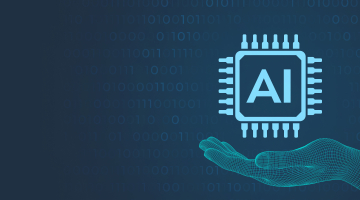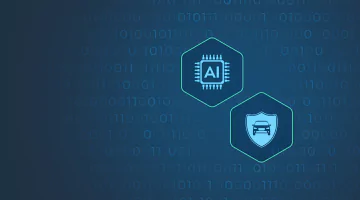

Artificial intelligence in banking: Role and impact for the industry
Artificial intelligence (AI) technology has gained unstoppable momentum in finance. AI in banking opens the horizons of sophisticated solutions that deliver the next level of ROI.
According to Statista, experts predict that the smart tech concept will be steadily generating over $50 billion for the banking industry by 2030, with today’s average market value of AI in fintech topping somewhere at $40 billion.
Strategic AI implementation in banking can deliver significant benefits. At DICEUS, we have a lot of experience in this field, so we decided to share thoughts on how AI tools prevail in the modern world of financial services.
Check out our AI expertise.
AI in banking: The history of development and the current state
Although AI has become quite trendy now, it has been around in one form or another for quite some time. The term was originally introduced in 1956 during the Dartmouth Summer Research Project on Artificial Intelligence (DSRPAI) sponsored by John McCarthy and Marvin Minsky.
After World War II, the global paperwork turnover grew dramatically, which required automation systems. In the 1960s, research focused on Bayesian statistics and was widely used in machine learning. In the mid-1970s, the “winter of artificial intelligence” began when government funding and interest in the field subsided.
The AI hype resumed in 1983 when the British government’s Alvi research project was funded by the military to compete with Japan’s Fifth Generation project. In the 1980s, more than two-thirds of Fortune 1000 companies developed at least one AI project.
In 1982, AI made its mark in the financial services industry when James Simons founded Renaissance Technologies, a quantitative hedge fund. As of April 2021, its market capitalization reached $165 billion.
Today, artificial intelligence in banking as a separate case study is used to efficiently identify fraud and suspicious transactions, achieve higher personalization, as well as boost customer credit assessments, cybersecurity, and overall risk management.
According to the BusinessInsider research, 80% of banks are aware of AI’s potential benefits, and 75% of the largest establishments are implementing projects based on it.
Banks are using AI to transform customer experiences, delivering uninterrupted 24/7 service. The back and middle offices of the investment industry and other financial services also benefit from the technology.
Benefits of AI in the banking industry
AI makes financial institutions more efficient and trustworthy, boosting their competitive edge. The growing influence of AI in the banking sector minimizes operational costs and improves customer support and process automation. In addition, the use of AI in banking helps users pick loans at an attractive interest rate.
Fraud detection and compliance
Banks prioritize compliance with industry regulations. AI allows you to automatically update processes and work in accordance with existing regulatory requirements.
It can also help minimize errors in reports by automating due diligence to keep accurate customer records at all times. In addition, AI can analyze large amounts of data and identify suspicious transactions, even the smallest ones.
Assessment of investments
The process involves collaboration between multiple teams responsible for various aspects of investment asset management, credit analysts, portfolio managers, and product specialists.
An AI-powered application can process large amounts of data from multiple sources in real time, learning each analyst’s preference and risk tolerance across a timeline. In other words, the algorithm will determine which options are based on fundamental and technical data rather than human factors.
Related article: Mobile banking risks: Top security dangers and remedies
Costs reduction
AI in the banking sector can improve the efficiency and productivity of individual employees. Decision Management Systems (DMS) enable you to make smarter decisions faster. In addition, the DMS helps speed up client connections by using predefined answers to common questions. Thanks to this technology, the company can do with a smaller staff.
Human error often results in dire financial consequences. DMS eliminates this risk by providing accurate and consistent data entry into the system. Plus, AI reduces labor costs by streamlining capital investment decisions and forecasting.
Credit scoring and KYC
A comprehensive assessment is required before opening an account. The required documentation depends on the customer profile. Credit appraisal can be time-consuming if there is not enough information about the client and their creditworthiness.
AI helps solve this issue by performing automated checks on internal databases and external data sources such as central banks, national statistical agencies, public property registers, company registers, and social media. This reduces the risks associated with non-compliance with KYC.
Client service
AI in the banking industry improves the quality of services through accurate and fast personalization (e.g., intelligent chatbots). Conversational interfaces automate repetitive tasks so people can focus on more complex problems. Another great aspect is that chatbots can use machine learning algorithms based on customer interaction. This allows you to increase sales and customer retention because they tend to buy products that they know about.
Just look what we do for banks.
AI use cases in banking
AI will help drive savings in three structural segments:
- Front office (conversational banking)
- Middle office (fraud detection and risk management)
- Back office (underwriting)
The most significant applications of AI and machine learning are in frontal and mid-sized offices. Now let’s take a look at some AI in banking examples.
Advanced analytics
Banking institutions register millions of transactions every day. The amount of information generated is enormous, so collecting and registering it, as well as determining the relationship between the collected data, becomes difficult.
Previously, a bank employee used to know the name and financial history of their client and understand which options are best to offer. Now, this is unrealistic since the banks have more clients, including those abroad.
AI applications collect and analyze data. This improves the user experience. The information can be used to issue loans or detect fraud. AI helps you evaluate potential profit using big data analytics.
Customer experience
AI-powered banking applications display services, offers, and information based on user search patterns. They can track user behavior and provide personalized suggestions based on that knowledge. This ultimately boosts convenience for users (clients) and is long-term beneficial for the bank.
Cloud services
The cloud is becoming a catalyst for corporate business transformation, changing the rules of the game for financial services providers. Cloud computing is coming to the fore as a priority for senior executives and board members.
Banking and capital market leaders are increasingly realizing that the cloud is more than technology. This is the place where financial services companies can store data and access advanced software applications online.
Leading cloud providers offer innovative products-as-a-services that help drive business and operating models, increasing revenue, boosting customer understanding, containing costs, and delivering relevant products faster.
The cloud can also help monetize corporate data. It offers tremendous opportunities for enterprise synchronization, breaking down the silos of operations and data for risk, finance, regulations, customer support, and more. Consolidating datasets in one place enables advanced analytics for integrated analysis. Companies can work entirely in the cloud or partially with an on-premises system.
Cybersecurity
Leveraging smart automation further, AI technology enables the implementation of advanced autonomous fraud detection algorithms. The real-time analysis of huge volumes of data greatly benefits cybersecurity. But there’s more than that.
AI systems are fast to detect out-of-place process patterns, flag operations that are potentially fraudulent, and learn to recognize new fraud attempts based on historical data analyzed by machine and deep learning algorithms.
AI’s ability to monitor processes, tasks, and customer behavior without any downtime makes it the most efficient method of cybersecurity tracking available today. For instance, a bank can go in-depth and employ advanced behavioral analysis and anomaly detection techniques. This will enable it to fend off sophisticated risks and threats, like APTs—advanced persistent threats—and zero-day exploits.
But how does AI help beyond the automated detection of threats? Cybersecurity processes can be automated throughout, with AI triggering the right response protocols (e.g., file isolation, notification, etc.) upon pinpointing a threat.
Various protocols can be prepared beforehand and developed continuously in action to prevent, fix, and eliminate future instances of all sorts of risks and threats. In addition to cyberattacks, these also include malware contamination, fraudulent identity authentication attempts, non-compliant processes, and non-obvious risks.
Chatbots
Intelligent chatbots with a database of specialized knowledge can answer queries and consult users downtime-free. A chatbot really helps leverage AI in commercial banking, allowing the bank to set up a 24/7 service, with customer or tech support available at all times. Chatbots already help banking customers handle simple routine tasks without going far, like checking an account balance or transaction status.
Natural language processing allows chatbots to answer queries in a conversational format. At the same time, a chatbot integrated with the bank’s existing system may gather a history of interactions with a specific user, making future interactions all the more personalized.
For more complex tasks, a bit more advanced chatbots can also help users open new accounts, process payments, and submit loan applications, all with detailed guidance. Furthermore, a chatbot can provide valuable financial advice and support important decisions, boosting the bank’s overall customer engagement and user satisfaction rates dramatically.
Need to develop a chatbot? Check out our chatbot development services.
Robotic process automation (RPA) and image recognition
AI and Robotic Process Automation (RPA) are two successful technologies that can improve customer satisfaction and employee morale while lowering operating costs.
End-to-end automation is the key to the self-service needed by a large number of customers. With RPA and AI, it is possible to fully automate the opening of a new bank account on the Internet. Before opening an account, the online chatbot checks the type of account that the client requires and provides them with a link to the corresponding form.
The completed form is submitted and passed on to another robot, which starts creating a new account. The robot performs internal tasks such as checking your credit score and running a know-your-customer check on Google and social media. It validates uploaded documents using text analytics and natural language processing to interpret and classify cue points from free text.
The robot verifies that the client’s name on the form and the driver’s license match and performs the operations necessary to create a new business account, interacting with the various server systems of the bank. The final decision is made by a person. Based on human input, the robot learns to respond to situations like this.
If the customer’s details meet the bank’s requirements, the robot automatically sends an email with a welcome message, account information, and credentials. Finally, the robot reports to the robot control room that the mission has been completed.
Natural language processing (NLP)
NLP enables an intelligent system (robot) to work according to your instructions based on dialogue. This involves building computers to perform tasks in the languages used by humans. Communication within the system is carried out using oral speech (voice input) or written text input.
Banks use AI algorithms in the front end to simplify customer identification and authentication, simulate live employees with chatbots and voice assistants, deepen customer relationships, and provide personalized insights and recommendations.
AI is also deployed by banks as part of their middle office functions for risk assessment, fraud detection and prevention, anti-money laundering (AML), and know-your-customer (KYC) regulatory audits.
Banks recognize the need for a holistic AI strategy that extends across all business lines, usable data, and relationships with partners and employees.
Intrested in AI development for banking? Check our offer here!
Challenges of adopting AI in banking
As much as it offers visible benefits, integrating AI banking-wise surely has its own challenges as well. Here’s what a bank, financial provider, or other type of infrastructure should prepare for.
Protecting data
Of course, the most sensitive and important thing to handle is all the data accumulated and stored by the bank or company. This may include internal BI (business intelligence), various financial reports, payment registries, and invaluable client data.
Steps to prepare:
- Make sure to study the most relevant data security compliance regulations in Europe and worldwide, including CCPA and GDPR, in order for a newly-integrated AI to uphold the data handling standard.
- Put a separate focus on cybersecurity measures and reinforce data protection through encryption and other advanced methods, like multi-level data access where AI doesn’t get access to certain layers (a specialized IT provider will help).
Leaving legacy software behind
Adopting AI means upgrading in line with the times, which is not something an existing bank’s software system is always prepared for. Theoretically, various AI tools can be integrated with a legacy system just fine. But that would be a counter-productive step — why not go all the way and update?
Steps to prepare:
- If your bank or finance company runs on legacy software and you are looking to integrate it with AI, you must first check your system’s compatibility. Achieving compatibility with advanced mechanisms in an old system may cost more than upgrading all the way.
- Get ready for potential downtime on the day of integrating with or migrating to an AI-enabled environment. Plan out the day of integration/migration, either announcing a date of tech repairs or using backup software and databases (if you have those ready, which is another thing to consider).
Reshaping workforce
Lastly, a bank’s or company’s existing staff simply may not be prepared for leveraging the newly integrated AI capacities. On top of tech and digital environments, all the new features and automation must also be integrated with the staff workflow.
Steps to prepare:
- Dive into some strategic planning and define which job positions could use AI capacities the most, like the most routine-plagued departments and data input specialists.
- Educate your employees and drive new technological adoption through upskilling/reskilling workshops and courses. Hire AI-educated mentors and work on guides and instructions.
Related article: Data governance for banks: Top 5 benefits of implementing
How to implement AI in banking: Steps and tips
With a good overview of all the benefits you get, use cases you can leverage, and challenges you should arm for, it’s time to consider the whole implementation process.
Get goals and use cases straight
First, draw up a roadmap for project implementation—the budget, potential timeline, scope of work, and tasks to handle. Make sure to have a list of pains and aspects where AI is most beneficial and consider use cases to implement based on it.
Beyond this, more planning should cover half of the preliminary project stages.
Get a team set
You will need a cross-functional team of specialists to implement AI integrations and transitions most smoothly. In particular, your AI-dedicated team should have IT specialists (like a PM, a designer and developer, or a DevOps professional), a data scientist, a business analyst, and a domain expert or two (like an AI consultant or tech lead).
Audit existing data
On top of safeguarding all the data, you should also prepare and audit all the data you are to feed your newly adopted AI model. All the AI input data must be high-quality, relevant, and easily available for the AI model to leverage it efficiently, self-educate, and scale over time. For this, data scientists clean and optimize data for AI training.
Pick your AI tech
There is a vast field of AI-enabled tech solutions to choose from. You need the tools that match your objectives without making you break the bank or take too many extra steps for full integration. This is where a specialist from a dedicated team will help make the best decision. However, we’d recommend setting your sights on cloud solutions right away, for cost efficiency and broad scaling opportunities in the future.
Consider an AI model
For new systems and custom purposes, “young” AI models with basic capabilities are taken and grown and trained based on a variety of input data. To make an AI model truly yours, you feed it your bank’s historical data. Specialized machine learning algorithms will help it expand actionable skills and become more in tune with your corporate attributes and workflow.
Set pilot runs and tests
Before launching a pre-trained, integrated AI in action, a data scientist should set up test runs using custom pilot programs. This will help test out how the AI acts in various field scenarios and adjust its responses. The model can thus be refined before real workflow.
Integrate and configure
A new AI model is integrated with the banking system via APIs and specialized middleware capable of supporting two-way data flow and AI interactions. All of this is usually handled by designers and developers with an AI expertise.
Monitor performance
With a fully implemented, running banking AI in place, you now need to maintain its performance and see how well it fits the purpose. Track and monitor AI actions and update the model with new data inputs to scale it.
Educate and train
As mentioned in the Challenges section above, you will need to help your employees discover the capacities of the new AI model. All related employees and stakeholders must be educated properly, which is the last stage to take care of when going for AI.
Artificial intelligence in banking: Real-world examples
We don’t have to reach far to reinforce our statement of the benefits and relevance of AI for banks — all the hugest and top-demanded banks and banking infrastructures of the world have adopted AI to a certain extent.
- Bank of America has developed a custom AI-based assistant Erica for its clients and is actively reinforcing its fraud detection and protection systems with smart technologies;
- Citibank leverages ML and AI capacities to automate a range of back-office tasks, from fraud detection and client document reviewing to automated loan applications processing;
- JPMorgan Chase has also invested in an authentic AI-powered assistant, with a very active take on AI adoption across all aspects, especially since the launch of an Explainable AI Center of Excellence and AlgoCRYPT Center of Excellence.
DICEUS service offering for banks
We offer a full scope of AI capabilities in banking use cases, including the development of performance management systems, a full range of analytics, advanced forecasting tools, and software platforms. Our software solutions enable financial providers to do the following:
- Provide better services, attract more customers, and increase revenue. We help optimize data aggregation and use, reduce regulatory and market risks, and successfully combat fraud.
- Leverage AI to build an intelligent customer relationship management (CRM) system with predictive capabilities based on historical data. Our team will help you determine how AI can benefit your bank.
- Empower AI and develop banking products and services faster and more efficiently through the use of the cloud. Our team will develop the right AI implementation and deployment strategy for your financial institution.
- Leverage OCR solutions to help your bank acquire and analyze digital visuals faster. Computer vision software will greatly simplify the work of staff and provide more reliable data analysis.
- Apply NLP solutions. Our team has experience in creating customized chatbots for banks and financial institutions. We conduct an in-depth analysis of the target audience to determine the optimal communication models and contexts.
In addition, DICEUS provides software development services for building a full-featured online banking system from scratch. If you need to modernize your existing web banking, we will do it at the highest quality!
We offer proprietary mobile banking solutions with many features, including account management, payments, money transfer notifications, and global positioning (GPS).
We provide RPA integration. Our experience includes solutions for risk management, compliance, AML, fraud checks, and customer support. Our teams are experienced in DWH architecture, ETL processes, aggregation, data migration, database maintenance, and retirement of legacy applications.
Leveraging the technological power of our financial software, we help streamline processes and achieve high profitability. We also modernize legacy systems, eliminate technical delays, and solve data management problems.
Our banking software development and industry expertise cover major banking systems, data warehouses, robotic process automation, cloud computing, and more.
At DICEUS, we kick off and complete projects, adhering to the best practices of business analysis by collecting both functional and non-functional requirements and system integration, which consist of the following steps: obtaining, cleaning, structuring data, writing, implementing an algorithm, training, and improving the model.
The application of artificial intelligence in banking has its own characteristics. The choice of services, such as computer vision, depends on the specific tasks and data used. Thus, their cost and quality depend on your needs. We are ready to create a unique AI algorithm for your bank. By cooperating with our team, you’ll be able to do the following:
- Manage your project with metrics
- Choose a suitable interaction model
- Get a guarantee of timely delivery of software
- Benefit from a strict quality assurance system
We have an extensive pool of seasoned talents waiting to take on your project. Ready to make the first step?
FAQ
What is the role of AI in the banking industry?
From a technological perspective, AI is a true driver of transformation and evolution in the banking industry. Today, it helps banks achieve higher operational efficiency across all departments, reinforce data protection and cybersecurity, and smartly personalize the customer experience.
AI enables banks to automate routine processes, detect and prevent fraud, guide customer interactions, and improve internal decision-making thanks to continuous data monitoring, collection, and analysis. By leveraging AI, banks can offer faster, more accurate services at lower operational costs while gradually learning to be even better for customers and more competitive in the market.
What are some common use cases of AI in the banking sector?
There are numerous ways to employ artificial intelligence in the banking sector. AI’s fraud detection and prevention algorithms help fend off many types of cyber threats and fraudulent activities, even sophisticated ones, through constant monitoring and data/interaction analysis.
To cut internal costs and minimize cumbersome routines, AI can autonomously give credit scoring and assess a potential customer’s creditworthiness using data from multiple connected sources. AI also helps personalize marketing campaigns and initiatives by gathering customer behavior insights and providing specialized advice.
Lastly, a custom AI-powered chatbot can become a real cornerstone of automation and customer experience advancement, providing fail-proof service for customers without downtime. Today’s chatbots handle a range of tasks, from simple consulting to potential customer evaluation and account registration.
What are the key benefits of implementing AI in the banking industry?
AI ultimately enhances the security of data, assets, and all the bank’s underlying operations. Smart integrations boost task performance and efficiency through automation, monitoring and analysis, personalization, and user engagement. With chatbots, a bank can achieve an outstanding customer experience.
The same algorithms focused on internal data can also help business owners and top managers make long-term valuable corporate decisions and gradually boost ROI. Lastly, with all of the above and more features, AI helps companies perform efficiently and scale more easily across the board.
Can AI improve credit scoring and risk assessment processes in banking?
Yes, AI can greatly help with efficient credit scoring and risk assessment. Traditional credit scoring models often rely on a limited set of financial data, which restricts the extent of data analysis.
Alternatively, AI-powered models are tuned for digging into a wide range of data sources, tracking such takeaways as transactional behavior, social media activity, and alternative credit data (coming from other still, disparate sources).
Such a multifaceted analysis allows for more accurate and inclusive credit assessments, identifying creditworthy individuals who might be overlooked by traditional methods. AI also continuously learns from new data, refining its predictions and reducing the risk of default.
How can AI-driven chatbots improve customer service in banking?
AI-driven chatbots improve customer service in banking in several ways:
1) They are available day in, day out, 24/7, without downtime
2) They respond to user queries instantly, saving everybody’s precious time
3) It personalizes interactions with the recurring users
4) It helps users handle simple yet routine tasks, like account registration or preliminary credit scoring
5) They save tons of costs both internally and externally in places where human intervention would only spawn more expensive errors





